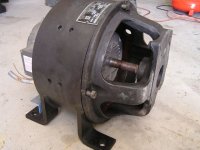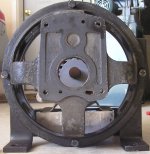I would install an intermediate plate in the old Reliance motor housing, perhaps on its end and also accepting a C-face motor (I realize this doesn't specifically address the O.P.'s situation), or possibly in the middle and retained by the old pole piece retention screw holes.
The first would be a simple bandsawn plate, finished on a large lathe. The second would be a weldment, possibly easier to finish on a smaller lathe.
After getting the alignment correct, the adapter shaft ... 1-1/8" I.D. to (probably 35mm) O.D. for the bearing to 1-1/4" O.D. for the backgear unit ... would be installed, completing the adaptation.
Possibly no need for a Lovejoy with this concept.
The backgear print which came with my '56 manual has the specifications for fitting a motor's shaft to the backgear's input, and this would apply equally to a shaft adapter.







